Abe Kuipers (1918-2016) was one of the city of Groningen’s leading graphic designers. He was self-taught in this field. He had graduated as an aspiring artist from the local Kunstnijverheidsschool in 1940. It was only after World War II that Kuipers acquired his phenomenal knowledge of typography and book design during frequent visits to the university’s library.
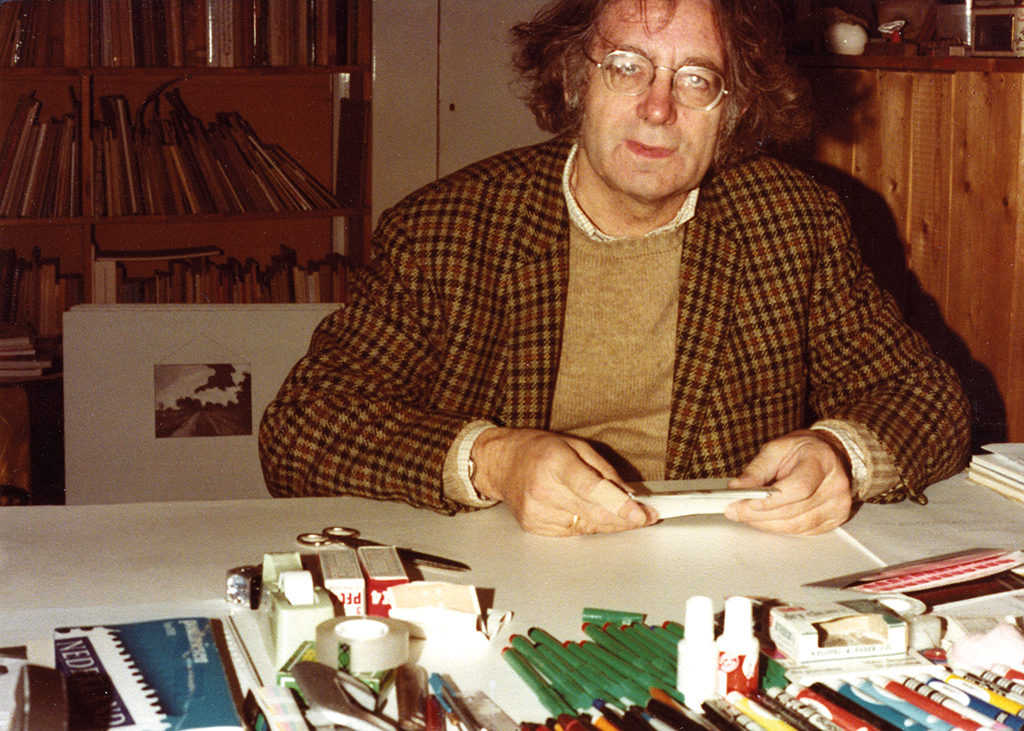
Abe Kuipers in his studio, 1972
Abe Kuipers is born on September 29, 1918, Rotterdam. Five months later, his father dies from the Spanish flu. His mother and her sons Abe and Reinold move back to Groningen. In 1932, Abe enters HBS trade school, where he also got drawing lessons. By visiting many expositions he awakens his interest in art. He admires the artists of ‘De Ploeg’ group and begins to paint. In 1937, he enters the Kunstnijverheidsschool (which will later become the Groningen art academy, Minerva). He gets more acquainted with art and with advertising as taught by artists, but typography and graphic design are not in the curriculum. Letters for posters are copied from books and brochures. Kuipers graduates in 1940, two months after German troops occupy the Netherlands.
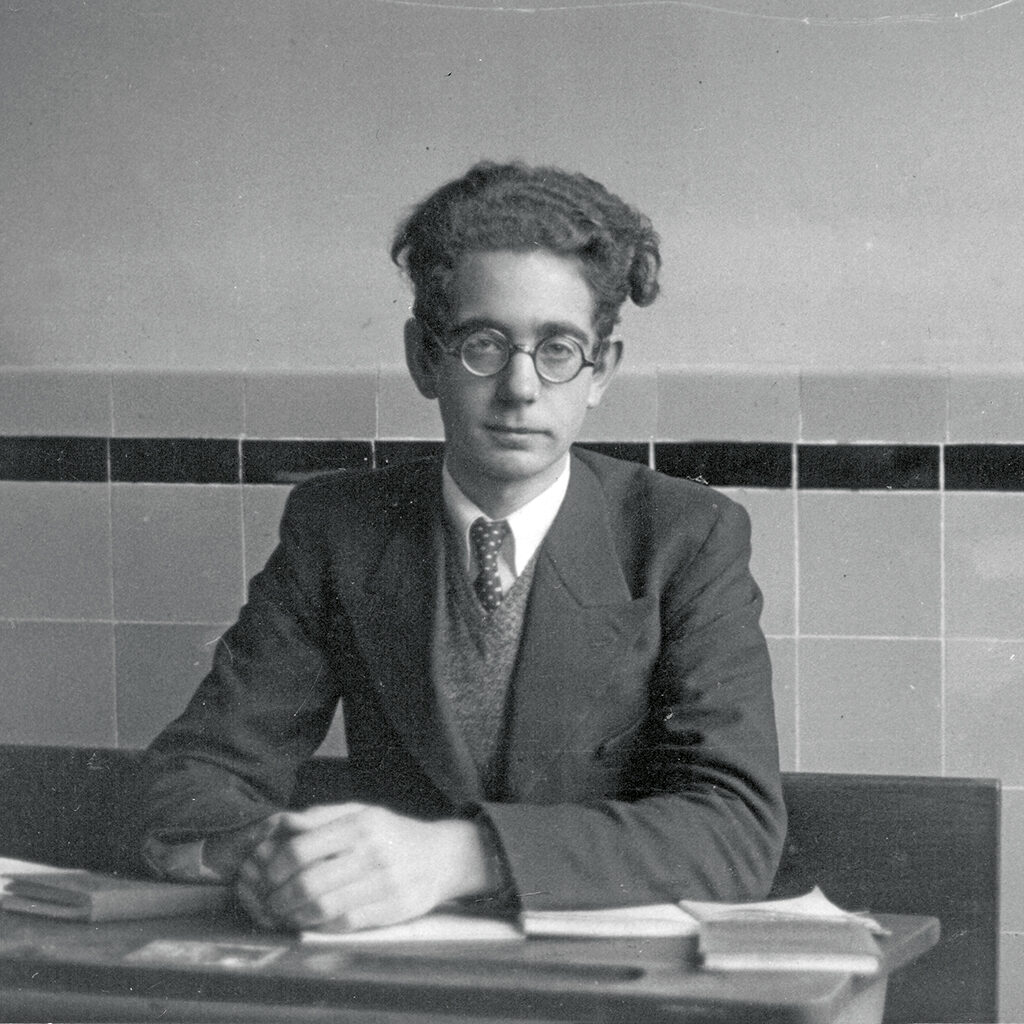
Abe at his secondary school, HBS, 1934

Abe in his art studio in Donderen, 1963
Photo: Bart de Vries
The occupation
During the confusing war years Abe Kuipers has a hard time making enough money, even as his art is well received. His brother Reinold, four years older, who had worked for printer Hoitsema in Groningen before moving to Amsterdam in 1936, publishes his first collection of poetry in 1939. Through Reinold, Kuipers is acquainted with the world of printing. He applies for a job with the Groningen advertising agency Drexhage & De Zee and learns mainly to design ads as an apprentice.
The brothers keep a correspondence going. Reinold through Abe writes copy for Drexhage, and through Reinold Abe gets jobs to design print. In 1943, to evade forced labor in Germany, Kuipers moves to the Noordoostpolder to dig trenches for the Germans. After a while, this no longer protects him against transportation to Germany and Kuipers decides to bicycle to Groningen and lie low until the war and the occupation will have ended.
Illicit work
Once back in Groningen, Kuipers tries to find illegal work. A school mate offers him pearwood to create woodcuts. Kuipers uses the wood to create illustrations inspired on work by the German Expressionists he had discovered in school; he self-publishes and designs a small book, Grönneger Laidjes. He calls his publishing start-up ‘De Vuurslag’ and has the first one-hundred copies of the booklet printed at Hendrik Werkman’s.

Page from Grönneger Laidjes, design and hand-colored woodcarvings, 1944

Page from Slingerpaden, poems by Hendrik de Vries. Design and hand-colored wood carvings, 1945

Wood carving from Tristan Derême, design and wood carving, 1946
Later, it is Drukkerij De Waal that prints several illegal publications for Kuipers. For the first time he sets eyes on a catalogue of types, and a new world opens. ‘The typesetters helped me who knew nothing to make my choices.’ Kuipers designs and illustrates several publications, including Slingerpaden, a volume of poetry written by his neighbor, the poet Hendrik de Vries, and Rijmprenten written by his brother Reinold.‘There was a shortage of paper. During curfew hours I sneaked to the much-admired Hendrik Werkman who had his workshop at Lage der A. Herman couldn’t help me. He told me: “Maybe later.” But lo and behold, the next day he had a whole stack of paper delivered to my door.’ Werkman gets executed by the Germans on April 10, 1945, six days before Groningen is liberated. Abe Kuipers together with writer Max Dendermonde create the illustrated broadsheet Groningen Bevrijd (Groningen liberated).
Studying at the library
At first, Abe Kuipers returns to Drexhage & De Zee to work part time. He is not enjoying himself: he’d rather design books. He looks for freelance projects and continues to produce his own publications. He is offered a teaching job at the graphic arts school and accepts. Goodbye advertising, hello teaching typesetters and printers, who are sent to attend class one day a week.
All his knowledge of script, from the birth of letters to contemporary typography and printing, Kuipers picks up in the library of Groningen University during the first five years after the German occupation. The library’s collection is extraordinarily large and diverse; one is even allowed to browse through incunabula. Kuipers is hooked. He starts collecting examples and to travel to museums to study more originals.
Sixty centuries of ABC
What he learns and collects in those years is brought together in the exhibition Fifty Years of ABC, which he organizes for Prinsenhof in Groningen in 1951. The exhibition ends with modern typography. Kuipers has become a member of GKf, forerunner of GVN and BNO, which allows him to meet some of the Dutch protagonists of this movement. Thus, he succeeds in getting work of Sandberg and Treumann among others for the exhibition. Critic Johan Dijkstra writes: ‘An exhibition that enters the deep past. There is so much to see and to learn from these fragments of script and book text, illustrations and other examples from different times presented here together.’

Opschrift, Op Schrift, written and designed by Abe Kuipers, published by Wolters-Noordhoff, 1968
Alas, documentation about this exhibition gets lost. But, later, Kuipers writes a book about his studies called Opschrift, Op Schrift, in which he presents writers from Egyptian times to mid-twentieth century printers. The book is published by Wolters-Noordhoff in 1968. As Kuipers says later: ‘My colleagues, such as Susanne Heynemann, Karel Treebus and Otto Treumann, came to graphic design from typography. They learned the profession from where it had all started. I respect them for their work. I started as an artist and switched to graphic design. A real typographer selects a type for its beauty. Whereas I see a page, then choose a type that suits the page.’

Poster Groninger Museum, 1956

Poster Groninger Museum, 1957

Poster Groninger Museum, 1957

Poster Danish Sculpture, city park Groningen, 1967

Poster Groninger Museum, 1966

Poster for the opening of Groningen University’s cultural anthropology museum, Groningen, 1978
Groninger Museum
In the same period Kuipers keeps growing as an artist. He has several shows and the jury of the Royal Award for Modern Painting selects his work for participation in a travelling exhibition that visits more than twenty locations in the Netherlands, called Start. Art critics admire the work of this Expressionist from Groningen. In 1948 he gets his first show in de Mangelgang gallery. He is invited to join the Groningen art collective ‘De Ploeg’ but he prefers to collaborate with groups who oppose their conventional approach: ‘Narrenschip’ (ship of fools) and later ‘Nu’ (now). It is Kuipers who takes care of the graphic designs for these groups’ publications and promotions. The artist Abe Kuipers meets the graphic designer Abe Kuipers.

Window display artists group Nu, Picturis Gallery, Groningen, 1965

Window display Joseph Beuys, Groninger Museum, 1970

Window display 300 years Groningen Liberated 1672-1972, City of Groningen, 1972
In 1955, Jos de Gruyter is appointed director of the Groninger Museum. The journalist and art critic from The Hague has to fire up the museum. Kuipers is asked to design an identity including all stationery as well as posters and catalogs. Later he will also be commissioned to design exhibitions. De Gruyter organizes and curates the exhibition of the group ‘Nu’ in 1960. Kuipers will remain the museum’s designer until 1978, also after De Gruyter has handed over the directorship to Bram Westers. Kuipers: ‘Working for the Groninger Museum brought me other commissions, from elsewhere in the province as well as from the city. At the same time, I got well known in wide circles because my art and my applied art, my work as a designer, gained visibility.’

Catalog Newly Acquired Art, Groninger Museum, 1960

Catalog Josef Israëls, Groninger Museum, 1961

Catalog Newly Acquired Art of Stedlijk, Groninger Museum, 1968

Catalog 400 years of Stage Theatre in Groningen, Groninger Museum, 1973-1974
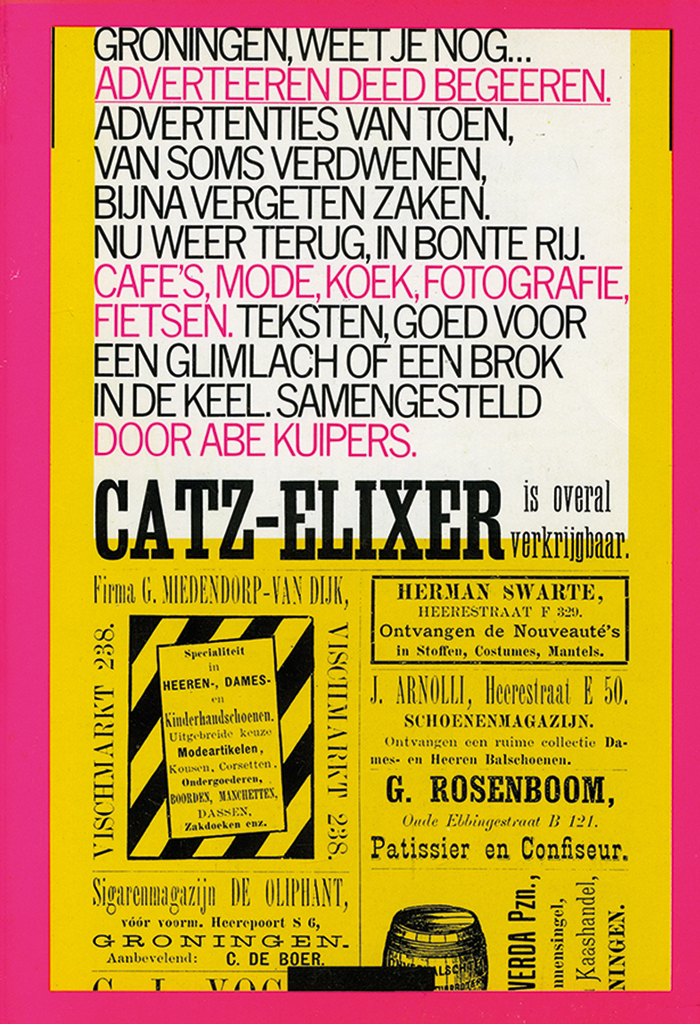
Groningen Remember…, production and design Abe Kuipers, 1980

Groningen Museum Under Construction, Part 1, 1978

Poster Danish Crafts, Groninger Museum, 1968

Annual report, Groninger Museum, 1969
Versatility
In the 1960s, all qualities Abe Kuipers had assembled in previous years come together. His art, his graphic design, his work for public space and his work as a teacher. Kuipers, more productive than ever, is involved with more and more commissions. He meets Tanja van der Wal at Erven van der Kamp printers, one of his clients. They marry and get two sons, Reinold and Auke. In 1962, he trades in his teachership at the graphic arts school for a position teaching typography and book design at AKI Art and Design Academy in Enschede. As a consequence, he has to travel and stay away from home overnight. But he enters a new and inspiring world, and at the same time finds more and more work coming to his desk in Groningen. ‘I wanted to be independent and take care of my own life. As an artist, designer and teacher I had to balance these three professions carefully. I succeeded by being painstakingly conscientious.’

Agricultural survey Groningen North, 1962

Groningen agricultural agency, 1962

The Future Has Started Already, publisher unknown, 1965

Between Yesterday and Tomorrow, Wolters, 1967

Sculpture En Route, catalog of 200 sculptures by 63 contemporary artists, all over Groningen, 1967

Brochure Linking Education and Industry, 1971

Logo 300 Years Groningen Free, 1972
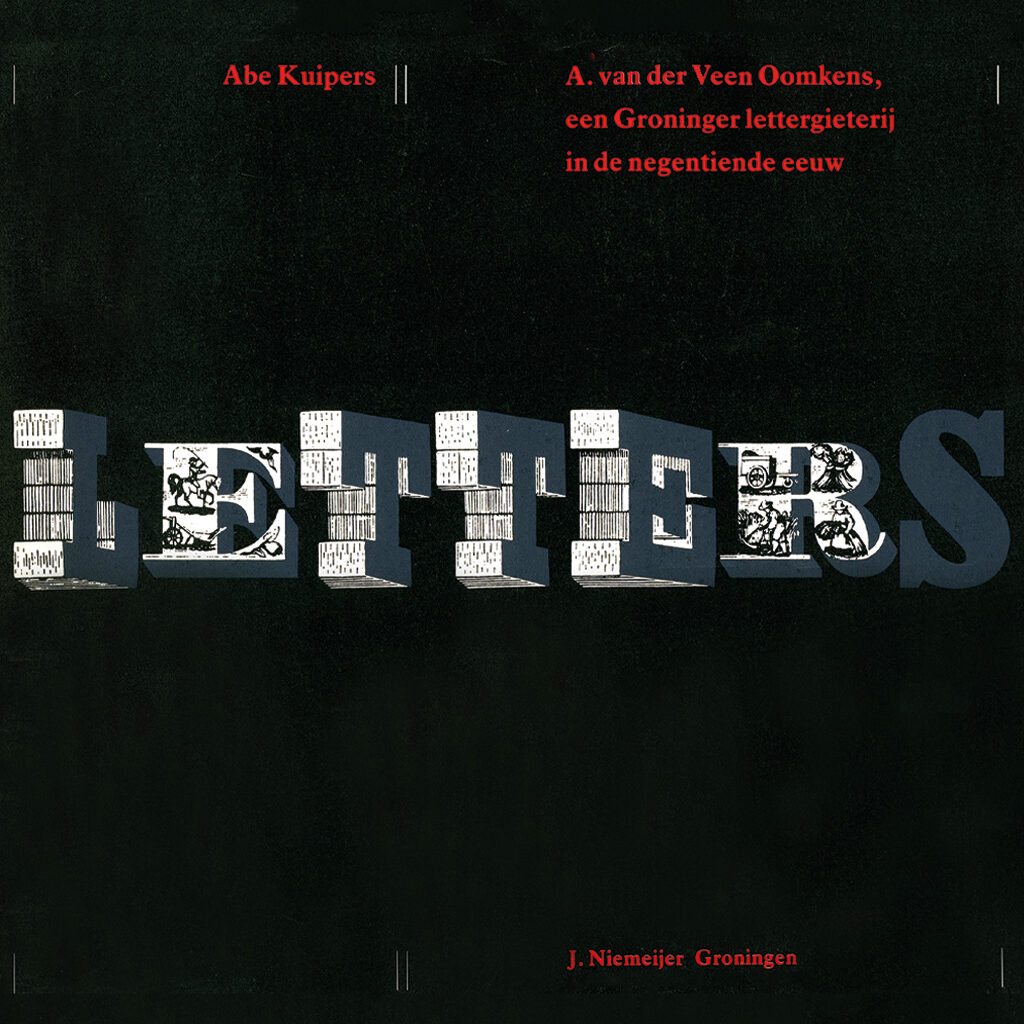
Letters, by Abe Kuipers, about A. van der Veen Oomkens, 19th-century Groningen type foundry, published by J. Niemeijer, 1987
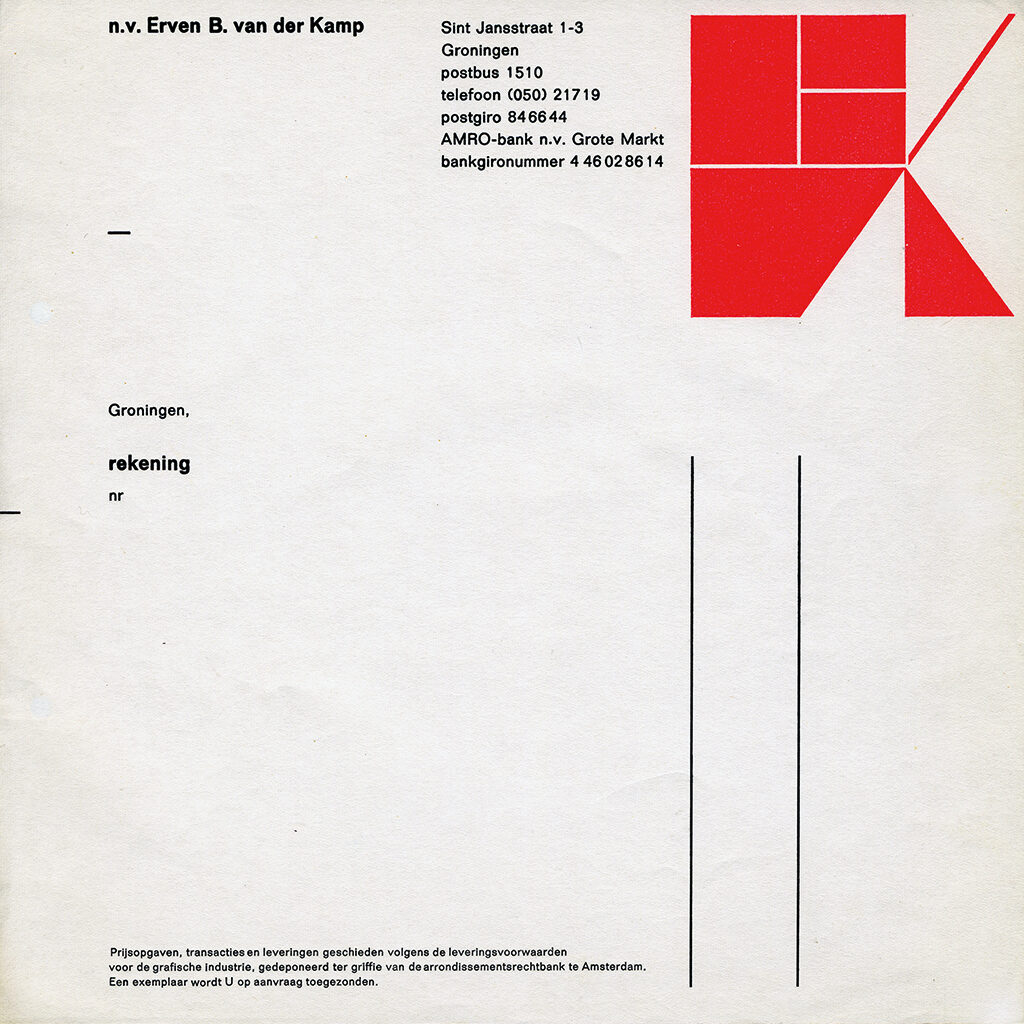
Identity program for Erven B. van der Kamp printers, 1987
‘Lètteretèt’
The wordplay cannot be translated: ‘Lètteretèt’ is a project Abe Kuipers manages to get subsidized and on the road in 1971. It aims to attract the larger public’s attention and interest to anything that has to do with typography, with letters. The poster Letters is distributed all over town and can be seen in display windows, on advertising columns, in schools, in libraries. Each letter’s origin is visualized. Many activities try to get the audience involved: awards are given to interesting applications of letters in the city. The Multatuli School’s teachers design a grid for their pupils to work with; only seen from a distance it becomes clear it is a huge letter M. On May 12, between 8 and 9:30 p.m., behind some of the windows of a big care home the lights are switched on one after the other until outside a huge B can be seen (the letter B is selected because it is the Phoenician sign for house or tent). The sociologists of Groningen University hold a survey on what random inhabitants of Groningen know about letters and about the psychological meaning of the letters G, A, B, K, U and S. The letter B appears to be the least dynamic of the group.


Creating the lighted letter B, 1971
The origin of the letter A, aleph in Phoenician,
detail from New Year’s wish card, 1971
‘This isn’t about showing that the windows of a high-rise apartment building can form a letter. This is to show the general public what letters are, what the alphabet is. The letter B as arranged for to light up at the façade of the Patrimonium building is just one element of the Lètteretèt project. The letter B’s origin lies in Phoenicia, the cradle of script, where B stands for house, home; the two arches of the B represent the arches of the Bedouin tent.’ – Abe Kuipers in response to discussions about the project in Nieuwsblad van het Noorden, April 7, 1971
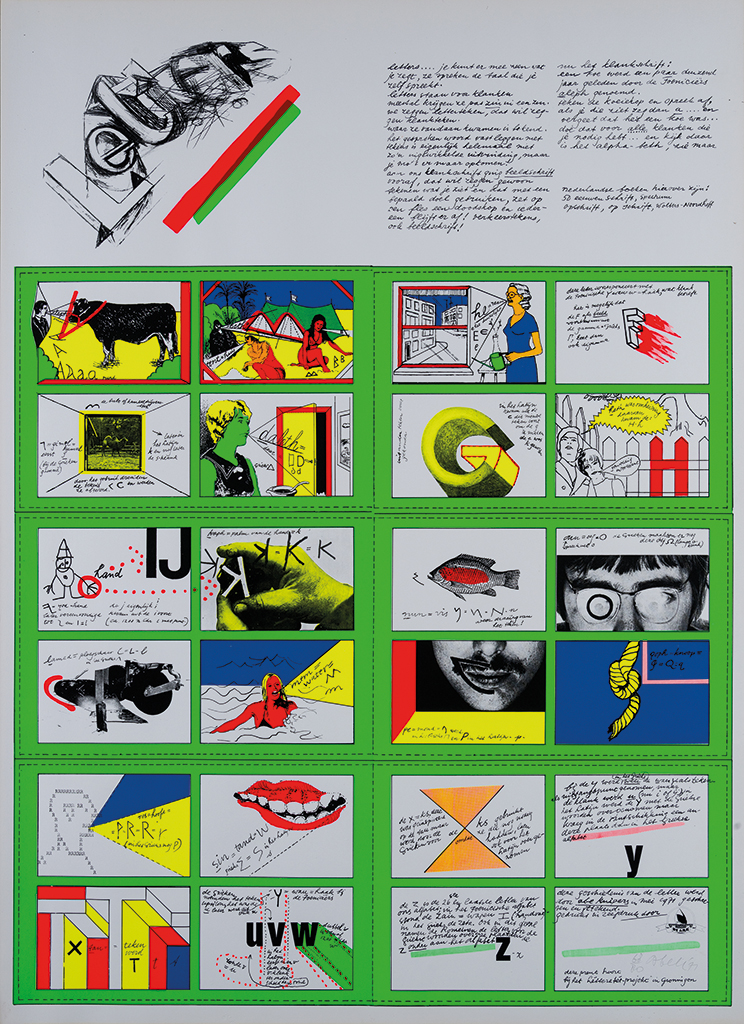
Poster Letters, the origins of the alphabet, screen print distributed all over Groningen, concept and design Abe Kuipers, 1971

Detail B from poster Letters, 1971

Cover of the final report on Lètteretèt, 1971
The town council is faced with a degree of controversy: ‘Is it right that, paid for with funds from local government, the folks living in a care home see their peaceful and quiet lives disturbed?’ Abe Kuipers couldn’t have dreamed of a more attention-grabbing start for his project. In the end, his extensive conclusive report about the project is called Red Green Blue Yellow. His poster Letters is selected for the IVth International Poster Biennale, in Warschau, Poland.
Public space
Abe Kuipers and his work attract attention. This results in a commission from the Province of Groningen to artistically supervise the design and construction of their new office extensions. Kuipers advises to also engage a photographer, John Stoel, and an artist, Drewes de Wit. Their collaboration lasts three years. Their advice is to not add grey and white to the new office building but to paint the building in black with red, green and blue colors for accents. The city reacts, opinions differ.

Routing system for the new library, 1975

Office of Groningen Province (detail), 1976

Announcement of concerts in De Oosterpoort, 1975
Kuipers gets new projects to advise about: the newly constructed Eems harbor and the new cultural center De Oosterpoort. In 1975, Kuipers is appointed as a consultant for a moving public library. He designs all sort of public information as well as the routing signs for the new and much discussed traffic circulation plan of the city. The plan and Kuipers’ proposals get national attention too. ‘In 1977, Groningencommissioner Jacques Wallage asked me to get involved. And suddenly I found myself a part of a complicated process in the city. My experiences as an artist and as a designer could be used to give the plan a social relevance. I loved this.’

Traffic sign for Groningen circulation plan, 1977
‘As one of the first in Europe, our city has given preference to the quality of the environment and thus created the conditions for an inner city of high standards, which receives recognition from everywhere. The clarity of the routing system designed by Abe Kuipers contributes to the system’s success.’ – Jacques Wallage, 1977
Art
In the 1960s, Kuipers also creates experimental films – his Collage Enfin is awarded. He designs pop art silkscreens and he does experiments with new etching techniques. Abstract art has his favor. Black and white are his colors. In 1970, the Groninger Museum organizes a solo show of his new graphic art and three-dimensional plastic and metallic objects that are related to his graphic works. About the relationship between his own art and commissioned applied art he says (Het Parool, December 1, 1977): ‘I have always split myself in so many pieces.’ The newspaper prints his poster Letters, granting it a full page.

New year’s wish card Abe and Tanja Kuipers, 1965
Wolters-Noordhoff
An important client is Wolters-Noordhoff, the publisher of educational books. Kuipers is allowed to create unorthodox work. ‘I am directed by the subject and my contact with the authors. The books have to convey their message and they don’t have to resemble a traditional schoolbook anymore. The responsible editor mostly agrees. The booklet Hebben en Zijn (to have and to be) is one of the clearest examples. It represents my vision on the Zeitgeist of the 1970s. I picked fonts and letter sizes and illustrations all based on the contents. An AKI student, Jan Verburg, created the illustrations. The book was selected to be one of the ‘50 Best Designed Books’. The book Inleiding tot de Natuurkunde (introduction to natural science) came about in a different way. I created the grid and basic lay-out for the typography and left the details to others to decide. I would never think of making a book about natural science into some kind of adventure. Also because I know Wolters would not sell one copy. But this book, too, was elected one of the 50 Best Designed Books, and moreover, it received an award at the annual design competition ‘Best Books From All Over The World’ in Leipzig.’

Wim Langeveld, To Have and To Be, Wolters-Noordhoff, 1970

Klompenhouwer & Van der Straaten, Introduction to Natural Science, Wolters-Noordhoff, 1968

Groenendijk & Van der Linden, Fundamental Natural Science 1, Wolters-Noordhoff, 1968
AKI
In 1962, Abe Kuipers applies for the function of teacher of book design at AKI, then the only academy in the Netherlands offering this specialized education. Although he is not officially licensed to teach, the academy hires him to teach first grade – his knowledge and experience in the field are unique. The study will eventually be integrated in the graphic design department. Kuipers follows his predecessor’s lesson plan but will also set his own mark: freedom in bonds.

Trip to London, students with Abe Kuipers and Wim van Stek, 1966

Appraising graduation projects, 1967
The 1970s are the years of important cultural changes at AKI, even if the academy for the time being continues to honor a rather conventional education system. Kuipers is content: his students are showing remarkable initiative and AKI adapts to the changing times. Students drift from one department to the other, are allowed to work at home, and join in group projects. Kuipers develops a tight relationship with many of his students, he is clearly enjoying how freedom stimulates creativity. ‘Pluriform not uniform, if only because of the outfit’ is his slogan.
Kuipers inspires many students with his knowledge and insight. He takes them on journeys through time by exposing them to communication using written as well as typeset texts. In the meantime, he continues his own development as a painter, sculptor, graphic artist, filmmaker, typographer and graphic designer. Kuipers refuses to be compartmentalized. His attitude teaches many designers to cross borders and opens up a world full of meaning.
At his farewell party in 1981 Kuipers is honored with a show titled ‘Last Night at Memphis’, a one-night-only performance in Concordia Theater in which AKI students play a variety of roles including as can-can dancers and as… Abe Kuipers. (‘Memphis’ is the name of the hotel where Kuipers used to spend the night between teaching days in Enschede.)
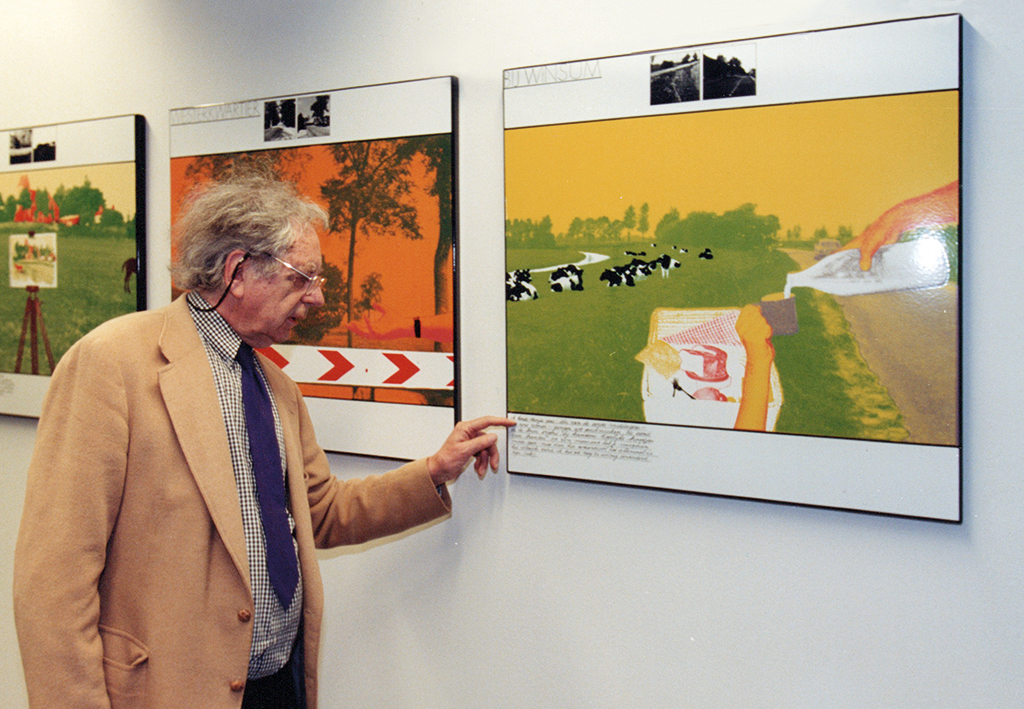
Abe Kuipers in front of panels he designed for the offices of Groningen Province in 1976, which were moved to the new Provincial House in 1997, where he sees them again. Photo: Jur Bosboom

Auke Kuipers and Stijn Hooijer, Abe Kuipers, A Profile, 2011. Design: Abe Kuipers
Werkman Award and more
In 1981, Kuipers is awarded with the H.N. Werkmanprijs 1980 for his total oeuvre as well as his role as an educator.The same year Kuipers decides to no longer accept commissions. He will spend the following thirty years as an independent artist. Script and signs will continue to be important in his life and in his art; letters keep showing up in his large oil paintings, pastels and prints.
In 2000, bookseller Godert Walter in Groningen honors Kuipers with the exhibition Keuze uit Zestig Jaar Grafisch Vormgeven/Ontwerpen (A selection of 60 years in design).
Foundation ‘Beeldlijn’ in 2007 produces a documentary film about Abe Kuipers directed by Buddy Hermans, Het Innerlijke Reservoir (The interior reservoir). At the same time, twenty of Abe’s large pastels are shown in the Groninger Museum. The City of Groningen acquires several of his works from different periods for the city hall collection.
Profiel Publishers produces the monography Abekuipers in 2011, designed by Kuipers himself; Stijn Hooijer is his co-contributor.
The Groninger Museum presents six large paintings by Abe Kuipers in 2014-2015. It will be his last public show.
In 2015, book designer Irma Boom poignantly interviews Abe Kuipers, then 96, for the documentary film Boom Maakt Boek (Boom creates book). This film directed by graphic designer Lex Reitsma will premiere in 2018.
Abe Kuipers dies on August 11, 2016. In a necrology in the daily newspaper De Volkskrant, Peter de Waard calls him ‘a creative centipede who left us an enormous and richly varied oeuvre’.
Abe Kuipers
born on 29 September 1918, Rotterdam
died on 11 August 2016, Groningen
Author of the original text: Ans van Genderen, 2022
English translation and editing: Ton Haak
Final editing: Sybrand Zijlstra
Portrait photo: Aatjan Renders
